Verification of tracks made of Sam
I made four tracks of Hurricane Sam,
before it was
assessed as
a tropical cyclone. I made three more track after cyclogenesis.
Additionally, within 504 hours of cyclogenesis, there were four instances,
when I missed cyclogenesis entirely.
As of this analysis, best track positions are available September 19, 00Z
thru October 5, 06Z, and as such, position comparisons are possible only
for this timespan.
Since I give only SSHS categories in my tracks, I don't
calculate intensity errors in units of speed, but in categories. For
this purpose, I define tropical or subtropical storms as "Category 0", tropical
or subtropical depressions as "Category -1" and non-existence of a tropical or subtropical cyclone as
"Category -2".
In the four tracks (made before operationally
recognized
cyclogenesis), formation times ranged between September 23, 00Z and
September 30, 00Z. Average was September 27, 03Z and median was
September 27, 18Z.
In the eight cases (4 tracks, before the tracks and data agreed,
that Category 4 would remain the peak intensity, and 4 complete
misses), peak intensity ranged between Category -2 and Category 5.
Average was Category -0.25 and median was Category -1.
In the seven tracks (made before operationally recognized extratropical transition), dissipation times ranged between October 1, 00Z
and October 10, 18Z. Average was October 4, 09Z and median was October 3, 18Z.
At the lead time of 1 day (24 hours), there were 3 hits, 0 false detections and 0 misses. 3 available position comparisons produce an average error of 59 nautical miles.
At the lead time of 2 days (48 hours), there were 3 hits, 0 false detections and 0 misses. 3 available position comparisons produce an average error of 70 nautical miles.
At the lead time of 3 days (72 hours), there were 3 hits, 0 false detections and 0 misses. 3 available position comparisons produce an average error of 113 nautical miles.
At the lead time of 4 days (96 hours), there were 3 hits, 0 false detections and 0 misses. 3 available position comparisons produce an average error of 141 nautical miles.
At the lead time of 5 days (120 hours), there were 2 hits, 0 false detections and 0 misses. 2 available position comparisons produce an average error of 229 nautical miles.
At the lead time of 6 days (144 hours), there were 1 hit, 0 false detections and 2 misses. 1 available position comparison produces an average error of 164 nautical miles.
At the lead time of 7 days (168 hours), there were 1 hit, 0 false detections and 3 misses. 1 available position comparison produces an average error of 109 nautical miles.
At the lead time of 8 days (192 hours), there were 1 hit, 0 false detections and 3 misses. 1 available position comparison produces an average error of 127 nautical miles.
At the lead time of 9 days (216 hours), there were 1 hit, 0 false detections and 4 misses. 1 available position comparison produces an average error of 237 nautical miles.
At the lead time of 10 days (240 hours), there were 1 hit, 0 false detections and 4 misses. 1 available position comparison produces an average error of 409 nautical miles.
At the lead time of 11 days (264 hours), there were 2 hits, 0 false detections and 3 misses. 2 available position comparisons produce an average error of 714 nautical miles.
At the lead time of 12 days (288 hours), there were 2 hits, 0 false detections and 3 misses. 2 available position comparisons produce an average error of 726 nautical miles.
At the lead time of 13 days (312 hours), there were 2 hits, 1 false detection and 3 misses. 3 available position comparisons produce an average error of 873 nautical miles.
At the lead time of 14 days (336 hours), there were 2 hits, 1 false detection and 3 misses. 2 available position comparisons produce an average error of 862 nautical miles.
At the lead time of 15 days (360 hours), there were 2 hits, 1 false detection and 3 misses. 2 available position comparisons produce an average error of 820 nautical miles.
At the lead time of 16 days (384 hours), there were 2 hit, 1 false detection and 3 misses. 2 available position comparisons produce an average error of 997 nautical miles.
At the lead time of 17 days (408 hours), there were 1 hit, 1 false detection and 5 misses. 1 available position comparison produces an average error of 1016 nautical miles.
At the lead time of 18 days (432 hours), there were 1 hit, 1 false detection and 5 misses. 1 available position comparison produces an average error of 1473 nautical miles.
At the lead time of 19 days (456 hours), there were 0 hits, 0 false detections and 4 misses. No available position comparisons.
At the lead time of 20 days (480 hours), there were 0 hits, 0 false detections and 3 misses. No available position comparisons.
At the lead time of 21 days (504 hours), there were 0 hits, 0 false detections and 3 misses. No available position comparisons.
Circle coloration scheme
Here are the tracks once again.
September 15, 06Z:
September 16, 06Z:
September 17, 00Z:
September 22, 06Z:
September 27, 06Z:
September 30, 12Z:
October 4, 12Z:
The complete misses were from the following model cycles:
September 2, 06Z
September 6, 06Z
September 10, 12Z
September 14, 06Z
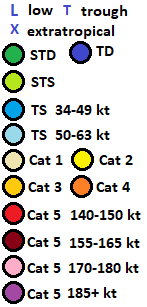
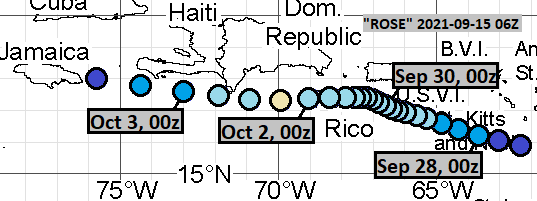
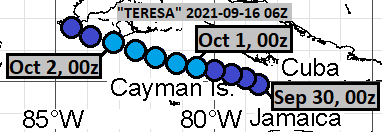
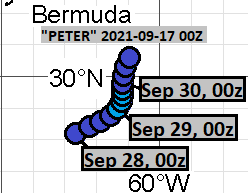

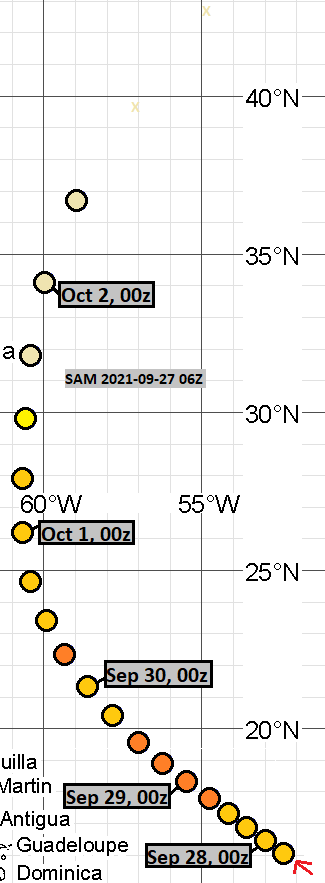

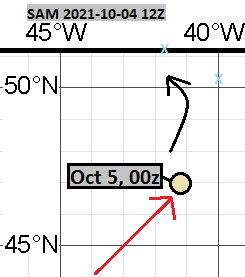
Comments
Post a Comment